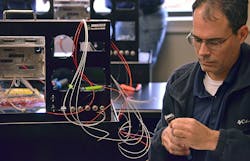Q&A With AEA President Paula Derks
AMT: First of all, who is the AEA?
PD: The Aircraft Electronics Association was founded in 1957 and represents nearly 1,300 member companies in more than 40 countries. Our membership includes government-certified international repair stations specializing in maintenance, repair, and installation of avionics and electronic systems in general aviation aircraft. It also includes manufacturers of avionics equipment, instrument repair facilities, instrument manufacturers, airframe manufacturers, test equipment manufacturers, major distributors, engineers, and educational institutions.
AMT: What qualifies an avionics shop for AEA membership?
PD: The fundamental requirement for an AEA member facility is certification from its civil aviation authority, such as the Federal Aviation Administration in the U.S. A certified repair station brings with it a degree of oversight that can’t be matched in the private sector. The certification standards, which now are higher than ever, guarantee specific capabilities and functions must be fully and continuously implemented for a facility to be, and remain, approved. By using this as a benchmark requirement, the AEA is able to validate certain qualifications universally proven to make a capable organization.
On a regular basis, aviation safety inspectors visit the approved facilities and conduct comprehensive evaluations of their compliance with the regulations. Because all AEA member shops are certified repair facilities, one can be certain they have the routine oversight of their regulatory agency.
AMT: What types of training programs are available to avionics technicians?
PD: AEA members have the opportunity to take advantage of hundreds of hours of technical training and professional development each year. These trainings are available at our annual convention, our AEA Connect conferences, and throughout the year at our Dan Derby Center for Professional Development in Lee’s Summit, MO. To the aircraft owner, this means the job will be done correctly and in accordance with the best practices, the manufacturer’s instructions, and the regulations.
The training includes everything from entry-level installation basics for new technicians to specialized training on integrated avionics suites provided by avionics manufacturers. AEA members who participate in these training sessions qualify for the Avionics Training Excellence Award, which further signifies an avionics shop’s commitment to providing the best service to its customers.
Installing or maintaining avionics in airplanes is a complicated and specialized business. Certified avionics shops, as representatives of avionics manufacturers, have access to all the necessary technical data and proper test equipment needed to work on the airplane. This is not necessarily true of an A&P, or even an IA, who is not working for a repair station.
It is an easy thing to buy a transponder from the Internet or a classified ad, but another thing entirely to get access to the current installation manual, or maintenance manual, plus the test equipment necessary to legally test and install the unit in an airplane. Many times, an installation is not just a simple wire-up and bolt-in job; it requires interface to several other avionics or airframe systems. The installer must have access to the technical data and be able to test the equipment, approved by all manufacturers and regulatory agencies, to make a safe installation.
When an avionics shop is approved for AEA membership, it has access to an organization that helps maintain a healthy industry. And a healthy avionics industry pays dividends to aircraft owners in terms of qualified technicians, stable business practices, and safe operations.
AMT: Is the ADS-B mandate the biggest issue facing your membership?
PD: Yes, and let me be clear: The industry is ready, willing, and able to support the Federal Aviation Administration’s mandate to equip all general aviation aircraft with ADS-B Out compliant solutions by Jan. 1, 2020. The AEA and other trade associations have been promoting early adoption to pilots and aircraft owners, but the installation pace must quicken.
Thanks to the engineering talent from several avionics manufacturers, there are a number of products available in the marketplace, particularly in the Part 23 world. As a result, the equipment costs have steadily decreased in recent months. It is not likely that the price of the equipment will drop much further.
But why are so many aircraft owners waiting to comply? Certainly, it’s human nature to procrastinate. But it’s also important to note that aircraft owners who delay installing ADS-B Out compliant equipment face the possibility of having their aircraft grounded in 2020 if they wait too long.
Why? Simply do the math, and it’s a case of supply and demand. The installation costs likely will increase as shops work overtime to handle the customer demand in future months. Avionics repair stations are already starting to accept appointments to complete these installations, and some of these appointments are months and years down the road. It is imperative that aircraft owners at least schedule an appointment to complete the installation prior to the deadline.
AMT: With less than 44 months until the deadline, what should avionics technicians be telling aircraft owners?
PD: Again, people often procrastinate when it comes to a deadline. Obviously, there is a “comply or don’t fly” element to help encourage more early adopters.
But what doesn’t get the recognition it deserves are the safety benefits available with ADS-B equipment. Although the mandate is for ADS-B Out, we are finding many aircraft owners are becoming more motivated to equip once they fully realize the benefits that come with having the optional ADS-B In equipment installed, as well.
When you factor in the free traffic and weather services available with ADS-B In, it simply makes flying more fun. Our shops often hear from customers who enjoy the overall flying experience much more after the installation. Add in the fact that the equipment can help avoid accidents, and more pilots and aircraft owners are being convinced to comply sooner rather than later.
The bottom line is that NextGen equipment not only provides added safety benefits, but flying simply becomes more fun. That’s a message that needs to be communicated more clearly with more aircraft owners as soon as possible.
AMT: Can you give us a preview of the AEA Convention in late April?
PD: Our member repair station owners look forward to this annual event for all the technical training, professional development, and networking opportunities available to them. We are coming off a record number of attendees last year in Dallas, but our advance registrations are on pace to break another attendance mark this year in Orlando.
We expect to see avionics shop owners and technicians from more than 20 companies in attendance and take advantage of more than 90 hours of professional development and technical training classes. We also will have more than 30 companies participate in our New Product Introductions session, which garners a lot of interest from the industry.
Each day begins with important regulatory updates, and we will be joined this year by FAA Administrator Michael Huerta at our regulatory session on April 28. More information is available on the AEA website at www.aea.net.


